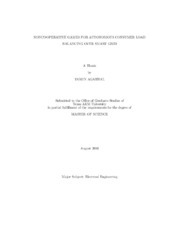| dc.description.abstract | Traditionally, most consumers of electricity pay for their consumption according to a fixed-rate. The few existing implementations of real time pricing have been restricted to large industrial consumers, where the benefits could justify the high implementation cost. With the advancement of Smart Grid technologies, large scale implementation of variable-rate metering will be more practical. Consumers will be able to control their electricity consumption in an automated fashion, where one possible scheme is to have each individual maximize their own utility as a noncooperative game. In this thesis, noncooperative games are formulated among the consumers of Smart Grid with two real-time pricing schemes, where the Nash equilibrium operation points are investigated for their uniqueness and load balancing properties. The first pricing scheme charges a price according to the average cost of electricity borne by the retailer and the second charges according to a time-variant increasing-block price. The zero revenue model and the constant revenue rate model, are the two revenue models being considered. The relationship between these games and certain congestion games, known as atomic flow games from the computer networking community, is demonstrated. It is shown that the proposed noncooperative game formulation falls under the class of atomic splittable flow games. It is shown that the Nash equilibrium exists for four different cases, with different pricing schemes and revenue models, and is shown to be unique for three of the cases, under certain conditions. It is shown that both pricing schemes lead to similar electricity loading patterns when consumers are interested only in the minimization of electricity costs. Finally, the conditions under which the increasing-block pricing scheme is preferred over the average cost based pricing scheme are discussed. | en |


